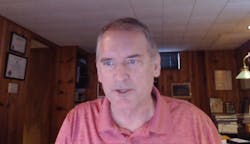ASHRAE's Bahnfleth Assesses Epidemic Task Force Performance
In myriad ways, the last year has tested the world, our nation, and this industry more rigorously and relentlessly than any other 12-month span in virtually all of our living memories.
As the Coronavirus pandemic has ruthlessly ravaged lives and economies across the globe, our industry has tried to respond as professionally, as comprehensively, and as rapidly as possible to urgent public health questions that may or may not be affected by HVAC systems in hospitals, schools, offices, factories, public transportation, etc. With all that in mind, ASHRAE a year ago formed the ASHRAE Epidemic Task Force, chaired by HPAC Engineering editorial advisory board member William P. Bahnfleth, Ph.D., P.E., an ASHRAE past president, and professor of architectural engineering at Penn State University.
Earlier this month, at ASHRAE's virtual Winter Conference, Bahnfleth updated attendees on his task force's evolving work, and its latest core recommendations for mitigating airborne infectious exposure. "With 15 teams working pseudo-independently and rapidly, what happens is that you can start to get some divergence on what's being recommended," he said, speaking at Seminar 27: MERV 13, HEPA and UVC: What Did Buildings Do During The Pandemic, and How to Make Your Buildings More Resilient for the Next Outbreak. (Like all sessions recorded at the virtual conference, this one will remain accessible online for the next year.)
"So we put together a list of core recommendations, partly to help keep ourselves focused on what we were recommending," Bahnfleth added. "But they are also useful for the outside world in summing up what is now over 350 pages of guidance into just one page, so they can understand what the main things are that we are trying to accomplish."
Reflecting on the past year of constant challenge, changing data, and high drama, Bahnfleth summed up his group's work.
"ASHRAE responded rapidly to the pandemic and provided guidance that was the best we could do at the time, that was conservative," he said. "But we've paid attention to new research, which has mostly confirmed that we were right in our approach."
- See the latest from the Task Force's Building Readiness Team.
In particular, ASHRAE from the beginning of the pandemic had been warning of airborne aerosol risk, but both the World Health Organization (WHO) and the U.S. Centers for Disease Control (CDC) for some reason did not reach that conclusion until last October. "Prior to that, we would get that question a lot: 'Why does ASHRAE differ from WHO and CDC?'" recalled Bahnfleth. "And the implication was, 'Why do we have to listen to what you have to say?'"
But now those questions have been settled.
Still, the ASHRAE Task Force did change some of its recommendations along the way, as new information emerged over the last 10 months. "The main drivers for change have been the feedback we've gotten on our feasibility and energy use impact, and also what we've learned from thinking about the Wells-Riley risk analysis model1 of infection," he added.
- Questions for Bahnfleth? Email him at [email protected].
That analysis has even influenced the group's enthusiastic endorsement of public health guidance on social distancing, masks, and hygiene.
"Masks are important because they limit droplet transmission by blocking sneezes and coughs, and the other thing that they do is block a significant fraction of the overall emissions," Bahnfleth explained. "So what's going into the air, the number of infectious quanta, can be greatly reduced by wearing masks. That helps us out even with airborne transmission."
Overall, he said, "we're adopting a total, uncontaminated air supply approach so that it's possible to combine ventilation, filtration, and air cleaners in ways that will help to meet energy use targets, to minimize the energy impact while still reducing risk."
##########
1 Derived in 1978 to model measles outbreaks in schools, the Wells-Riley equation helps building operators understand the contribution of the HVAC system to the overall risk of spreading the disease and the utility of different strategies in decreasing that risk. For more, click here.
About the Author
Rob McManamy
Editor in Chief
An industry reporter and editor since 1987, McManamy joined HPAC Engineering in September 2017, after three years with BuiltWorlds.com, a Chicago-based media startup focused on tech innovation in the built environment. He has been covering design and construction issues for more than 30 years, having started at Engineering News-Record (ENR) in New York, before becoming its Midwest Bureau Chief in 1990. In 1998, McManamy was named Editor-in-Chief of Design-Build magazine, where he served for four years. He subsequently worked as an editor and freelance writer for Building Design + Construction and Public Works magazines.
A native of Bronx, NY, he is a graduate of both the University of Virginia, and The John Marshall Law School in Chicago.
Contact him at [email protected].

